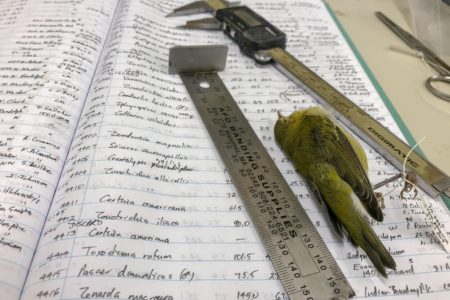December 6, 2019 – A shared morphological consequence of climate change is becoming evident in North American bird populations according to a study appearing in the December 4, 2019 issue of Ecology Letters. Biologists have observed that a warming world has affected the body size of a wide range of fauna in the geological past, but this appears to be the first definitive study covering four recent decades of observation that correlates to anthropogenic warming of the atmosphere and planet.
In the published paper it notes that “within species, there is evidence that individuals tend to be smaller in the warmer parts of their ranges.” This isn’t bird dependant. As the paper states, “the possibility of body size reduction in response to global warming has been suggested for decades.”
What has been missing to date, is a detailed study looking at a range of species to seek confirmation of this hypothesis. Collections Manager Emeritus at the Field Museum in Chicago, David Willard, started measuring migrating birds passing through the Windy City in 1978. He gathered 70,000 birds from 52 species and found body sizes were shrinking through the decades while wingspans were growing. The decline was consistent over all 52 species even though these birds came from very different sides of the avian population. Willard matched his bird size data with NASA temperature records for the areas where the birds breed showing a strong correlation. The average body shrinkage was 2.4% while wings lengthened by 1.3%.
The multi-decade results don’t, by themselves, prove a direct correlation between size reduction and global warming, but Willard’s research looked at short-term temperature changes as well within the four-decade time span and saw consistent correlation. So we can begin to see more complexity in climate change impacts on fauna, in this case, birds, than just shifting migration timing and ranges based on different degrees of warming.
How did Willard collect all these bird samples? Since the late 1970s, he started recovering bird-collision kills by Chicago’s skyscrapers during spring and fall migrations. Back in the 1970s, even a low-rise building like Chicago’s convention centre, McCormick Place, saw as many as 2,000 bird collisions a year. Today because of conservation concerns during the migration season, the number has dropped to about 500 each spring and fall.
Studying migratory birds has unique advantages when looking at climate change correlations. This is particularly true for birds that breed in polar latitudes where warming is doubling beyond the global mean. For example, in Canada where the mean temperature has risen 1.5 Celsius (the rest of the planet has seen a 1.0 Celsius increase), the country’s north is experiencing a 3 Celsius rise.
Willard’s sampling is probably the best record ever kept of diverse migratory bird species. What appears to be happening is birds are adapting to changing local conditions determined by the temperature at breeding sites and wintering grounds, the macroecological impacts to food sources, precipitation, vegetation, and other changes.
What are the unknowns in Willard’s study?
don’t know the exact breeding and winter locations of individual bird specimens collected. But that issue to a large extent is mitigated by the large sampling size.
We also don’t have a satisfactory explanation for changes in relative wing lengths. One of the puzzles is, wing lengths from spring migrations are longer than those from the fall and the trend is accelerating. It could be that there is a clear selective advantage in this pattern of longer wings which may provide for more efficient flight, but figuring out the exact reason remains a challenge.
In its conclusions, the Willard paper describes what is being observed as “developmental plasticity” related to increased temperatures during life stages across the 52 species studied. “Warming temperatures could conceivably relax selection for larger body size, indirectly leading to size reduction.” It further concludes that “body size reduction is likely to have far-reaching ecological consequences. The concomitant increase in wing length may have similarly expansive ecological implications, particularly as the divergent trends…combine to drive a change in shape.”
Are birds the only species on the planet notably shrinking?
Apparently so are wasps which according to Carlo Polidori, an entomologist at the University of Castilla-La Mancha, in Spain, who has been doing similar samplings for the National Museum of Natural History in Madrid.
Other studies by paleontologists have shown that during past periods here on Earth when natural global warming was the driving force for change, beetles, bees, spiders, algae called diatoms, and a variety of mammals all shrank based on fossil evidence.
So will we too shrink? We should know within the next century if what has been observed in nature will impact more than our global economy which undoubtedly will shrink.








